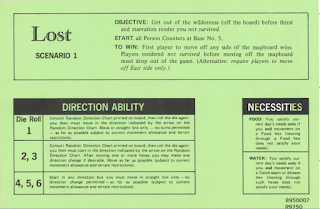Scenario Cards
Outdoor Survival isn't just a single game; it's actually a whole bunch of games, even an open-ended platform for making your own games (sound familiar?). The boxed set comes with 5 "Scenario Cards" which respectively outline completely different objectives, win conditions, and rules for being lost and finding sustenance. In the interest of comment, criticism, scholarship, and research, here's the front side of each of the cards:Aside from the context and objectives changing, the key observation is this: The scenarios represent a simulation of characters with progressively greater experience in surviving and navigating the wilderness.
Scenario 1, "Lost", is a situation with totally unprepared and disoriented characters stranded in the wilds; there is always some restriction on their movement. Looking on the left under "Direction Ability", they must always travel their full movement allowance. Half the time their movement starts in a random direction; only 1/3 of the time are they allowed even a single turn; the best they can hope for is being able to pick a direction of their choice and go in a straight line, full distance. On the right under "Necessities", their daily food and water requirements are almost never met. The only way that happens is to end a move directly on one of the few food hexes or a stream/water basin; and recall that players cannot choose how far to move in any event! I interpret this as a completely unaware lost soul, with no map, compass, food, or even a canteen with which to take water out of a stream when they pass one by. Indeed, the normal end to this game is everyone dying, no matter how well you try to play.
But on the other hand, as one progresses through the scenarios, these heavy restrictions are lessened. Direction ability options become more often a matter of player choice, and food/water become easier to collect and maintain. For example: Scenario 4, "Rescue", clearly features expert outdoorsmen looking to find and extract stranded victims. There is never any random direction taken; the choice is always up to the player, and they choose exactly how far to travel, and only half the time have any restrictions on the number of turns they make. Water supply is automatically full in all cases; the water index loss rule is completely a non-issue for these characters (full canteens?). Food may be found in any hex whatsoever, and certainly by passing through any indicated food hex. Simple survival and navigation about the map is all but guaranteed here; these characters are dealing with entirely different mental challenges than those in Scenario 1, say.
In short: The Outdoor Survival scenarios provide the germ of the idea of advancing character levels in D&D. Which is arguably the single most powerful game-design invention of all time. The scenarios provide a spectrum of characters of increasing knowledge and proficiency in surviving the challenges of the wilderness. At the lowest level, death is the most likely outcome, even with the best of strategies on the part of the player. But the strategy and game itself is entirely different as we advance experience. At the highest levels, mere survival is assured, those concerns are swept from the mental space of the game, and instead we wrestle with different, higher-order challenges.
Likewise as in D&D, it may be considered somewhat counter-intuitive that the hardest game (to simply survive) is at the introductory, lowest levels. If someone plays only Scenario 1 of Outdoor Survival, and dies several times in sequence, then perhaps they are not incited to play the other, higher-level scenarios which are actually much easier to win at (due to increasing character proficiency). The traditional boardgame gesture is that more "advanced" scenarios are adding more and more rules, and hence increasingly hard to manage the play/strategy. Here this is reversed; higher levels actually remove certain rules from consideration (like the need to track water resources). If someone were committed to winning the first "level" before proceeding to others (which is not guaranteed in any case), then it is no wonder that they walk away from Outdoor Survival with the impression that it is simply an assured massacre on every play of the game.
Finally, consider the expression of the same kind rule for being lost in Original D&D (Vol-3, p. 17). While it doesn't perfectly match any of the "Direction Ability" tables above, it is more like the higher-level ones than the lower. Again on a low roll, the PCs may have to start in a random direction and be restricted to a single "turn" in their move. But this chance is lessened (either on only a 1, 1-2, or 1-3, depending on terrain), and at no time are they required to move their full speed for the day. Meanwhile, traditional D&D never included any rules for adjudicating a lack of food or water. D&D seems to expect that only the "highest level" of Outdoor Survival characters will be active in its wilderness play.
Still more to come.


















